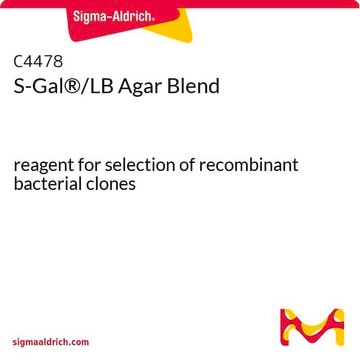16669
Magenta-Gal
reagent for selection of recombinant bacterial clones
Sinónimos:
5-Bromo-6-chloro-3-indolyl-β-D-galactopyranoside, Mag-Gal
About This Item
Productos recomendados
grade
for molecular biology
Quality Level
sterility
non-sterile
assay
≥98.0% (HPLC)
form
powder
solubility
DMF: soluble
DMSO: soluble
suitability
suitable for β-galactosidase test
storage temp.
−20°C
SMILES string
OC[C@H]1O[C@@H](Oc2c[nH]c3cc(Cl)c(Br)cc23)[C@H](O)[C@@H](O)[C@@H]1O
InChI
1S/C14H15BrClNO6/c15-6-1-5-8(2-7(6)16)17-3-9(5)22-14-13(21)12(20)11(19)10(4-18)23-14/h1-3,10-14,17-21H,4H2/t10-,11-,12+,13-,14-/m1/s1
InChI key
CHRVKCMQIZYLNM-RKQHYHRCSA-N
General description
Application
Principle
related product
Storage Class
13 - Non Combustible Solids
wgk_germany
WGK 3
flash_point_f
Not applicable
flash_point_c
Not applicable
ppe
Eyeshields, Gloves, type N95 (US)
Choose from one of the most recent versions:
¿Ya tiene este producto?
Encuentre la documentación para los productos que ha comprado recientemente en la Biblioteca de documentos.
Nuestro equipo de científicos tiene experiencia en todas las áreas de investigación: Ciencias de la vida, Ciencia de los materiales, Síntesis química, Cromatografía, Analítica y muchas otras.
Póngase en contacto con el Servicio técnico







